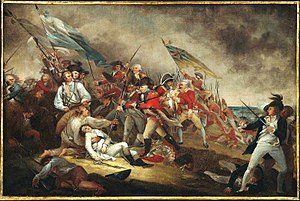Battle of Bunker Hill
Battle of Bunker Hill
Part of: American War of Independence

The Death of General Warren at the Battle of Bunker Hill. Painting by John Trumbull
AmericanWar of IndependenceNorthern
Campaign
Lexington and Concord, Boston, Bunker Hill, Long Island, Kips Bay, Harlem Heights, Pell's Point, White Plains, Fort Washington, Trenton I, Trenton II, Princeton
Bunker Hill was a battle in the American War of Independence. It took place on June 17, 1775, during the Siege of Boston. Although known as "Bunker Hill" ("Bunker's Hill"), it largely took place on Breed's Hill ("Breed's Hill"). The British Army under William Howe drove the American militia out of the fortified positions at Bunker Hill and Breed's Hill. The battle was a Pyrrhic victory for Howe. His immediate objective was achieved, but the attack demonstrated American staying power, caused significant British casualties, and did not change the status of the siege.
Background
Boston had been occupied by the British Army since 1768. In May 1774, General Thomas Gage had declared martial law in Massachusetts. Since April 19, 1775, his forces in Boston had been besieged by 8,000 to 12,000 militiamen, led mainly by General Artemas Ward. In May, the British garrison was reinforced by the arrival of over 4500 additional troops and Major General William Howe. Admiral Samuel Graves commanded the naval units in the harbour.
General Gage began work with his new generals on a plan to break the siege forces' grip. They wanted to launch an attack by land and sea to drive the Americans from Dorchester Heights or capture their headquarters at Cambridge. To thwart these plans, General Ward ordered General Israel Putnam to fortify Bunker Hill.
The battlefield
The Charlestown Peninsula extends about 1,600 yards southwest into the Boston Harbor basin. At its narrowest point, only 1,600 yards separate it from the Boston Peninsula. Bunker Hill is an elevation in the back of the peninsula, and Breed's Hill is near the Boston end, while the city of Charlestown occupies the flats of the southern end.

Sketch of the battlefield on the Charleston Peninsula and the deployment of troops on June 17. George E. Ellis (1875)
Questions and Answers
Q: What was the Battle of Bunker Hill?
A: The Battle of Bunker Hill was a battle in the American War of Independence which took place on June 17, 1775. It was fought mostly on and around Breed's Hill during the Siege of Boston early in the American Revolutionary War.
Q: Where did it take place?
A: The Battle of Bunker Hill took place mostly on and around Breed's Hill, during the Siege of Boston.
Q: Why is it sometimes called "Battle of Breed's Hill"?
A: The battle is sometimes referred to as the "Battle of Breed's Hill" because that is where much of the fighting occurred.
Q: What happened leading up to the battle?
A: On June 13, 1775, colonial troops under William Prescott learned that British generals were planning to send troops out from the city to occupy unoccupied hills around Boston. In response, they stealthily occupied Bunker Hill and Breed's Hill and constructed an earthen redoubt on Breed's Hill and built lightly fortified lines across most of Charlestown Peninsula.
Q: Who won the battle?
A: The British forces won the battle but suffered heavy casualties with over 800 wounded and 226 killed among them many officers. This led to it being seen as a Pyrrhic victory since immediate gain (capture of Bunker hill) was small but cost high. Meanwhile, colonial forces were able to retreat with fewer casualties than their opponents.
Q: How did this demonstrate inexperienced colonial forces could stand up against regular army troops?
A: Despite suffering more losses than their opponents, colonial forces were able to retreat in good order due to having suffered fewer casualties overall compared to British forces which demonstrated that even inexperienced colonial forces could stand up against regular army troops in a pitched battle if necessary.
Search within the encyclopedia